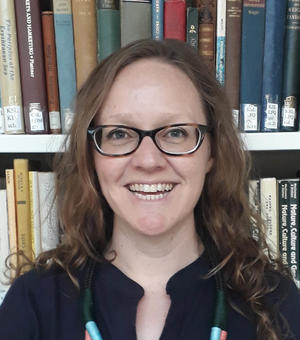Dr Ashley Coutu
Research Summary
My research is interdisciplinary, reflecting interests and training across fields such as African archaeology, biomolecular archaeology, and historical ecology. Much of my research focus has been on ivory and its use and trade of exchange across southern and eastern Africa from the last 2,000 years. I am particularly interested in the use of scientific techniques such as stable isotope, proteomic, and ancient DNA analyses to trace trade networks and how past people utilised ivory and their relationships with elephants. Most of my recent projects have involved researching museum collections of organic materials which reveal animal – human relationships over time, as well as trying to uncover environmental knowledge and histories with museum archives (https://takingcareproject.eu/; https://www.prm.ox.ac.uk/activating-archive ).
CV
Ashley Coutu is Senior Research Curator and Deputy Head of Research at the Pitt Rivers Museum. She received a BA from Boston College, USA in 2005, then moved to the UK to complete an MPhil in World Archaeology from the University of Cambridge in 2007. From 2007-2011, she completed her PhD as a Marie Curie Early Career Researcher on the EU-funded Historical Ecologies of East African Landscapes project at the University of York. Her PhD used a combination of archival, archaeological, and biomolecular data to understand the impacts of the 19th century ivory trade on elephants, humans, and landscapes along caravan routes in East Africa. In 2012, she moved to Denmark as a postdoctoral researcher on the Entrepôt project and from 2013-2017 was based at the University of Cape Town, South Africa, holding a Claude Leon fellowship and then a Marie Curie International fellowship. The two fellowships centred on a project to map African ivory trade networks from the last 2,000 years by analysing ivory working materials, ivory objects, and other small finds from archaeological sites across southern Africa. After moving back to the UK in 2017, Ashley spent time as a Visiting Research fellow at the Sainsbury Centre for Visual Arts at the University of East Anglia and then took up a post as a Lecturer in Archaeology at Newcastle University, where she developed curriculum in global medieval archaeology with collections at the Great North Museum.
Publications
Lane, Paul J., and Ashley N. Coutu, (2022) "The Trade, Use, and Circulation of Elephant Ivory in Sub-Saharan Africa over the Longue Durée." Oxford Research Encyclopedia of Anthropology. (19 Oct. 2022)
Antonites, A., C. Ashley, A. Coutu, S. O’Connor, and S. Tiley-Nel. 2022. “Object Biography of a Decorated Ivory Artefact from Vryheid (MNR04), a Late Iron Age Site in the Limpopo Valley of South Africa.” South African Archaeological Bulletin 77 (216): 4–16.
Coutu, A., and P. Lane. 2021. “Ivory in West Africa, C. 100 to 1900 CE: Archaeological Evidence and Future Research Priorities.” In African Ivories in the Atlantic World, edited by da Silva Horta, José and Almeida, Carlos. University of Lisbon (CH-ULisboa) - Lisbon Historical Studies.
Alida de Flamingh, Ashley Coutu, Judith Sealy, Shadreck Chirikure, Armanda D.S. Bastos, Nzila M. Libanda-Mubusisi, Ripan S. Malhi, Alfred L. Roca, (2020) "Sourcing Elephant Ivory from a Sixteenth-Century Portuguese Shipwreck", Current Biology, Volume 31, Issue 3, pp621-628. https://doi.org/10.1016/j.cub.2020.10.086.
Flamingh, A. de, Coutu, A.N., Roca, A.L., and Malhi, R.S. (2020) Accurate Sex Identification of Ancient Elephant and Other Animal Remains Using Low-Coverage DNA Shotgun Sequencing Data. G3: Genes, Genomes, Genetics. DOI:10.1534/g3.119.400833
Coutu, A.N. and Damgaard, K. (2019) “From Tusk to Town: Ivory trade and craftsmanship along the Red Sea” Studies in Late Antiquity 3 (4): 508–46.
von Holstein, I., von Tersch, M., Coutu, A.N., Penkman, K.E.H., Makarewicz, C.A. and Collins, M.J. (2018) 'Collagen proteins exchange O with demineralisation and gelatinisation reagents and also with atmospheric moisture'. Rapid Communications in Mass Spectrometry. DOI: 10.1002/rcm.8064
Coutu, A.N., Lee-Thorp, J., Collins, M. and Lane, P. (2016) 'Mapping the elephants of the 19th century East African ivory trade with a multi-isotope approach'. PLoS One. DOI: 10.1371/journal.pone.0163606.
Coutu, A.N., Whitelaw, G., LeRoux, P. and Sealy, J. (2016) 'Earliest evidence for the ivory trade in southern Africa: isotopic and ZooMS analysis of 7th-10th century AD ivory from KwaZulu-Natal'. African Archaeological Review 33 (4) 411-435.
Coutu, A.N. (2015) The elephant in the room: mapping the footsteps of historic elephants with big game hunting collections. World Archaeology 47 (3) 486-503.
Coutu, A.N. (2018) Ancient molecules connect the past to modern conservation. In Daryl Stump and Christian Isendahl (eds) Applied Archaeology, Historical Ecology and the Useable Past. DOI: 10.1093/oxfordhb/9780199672691.013.14
Ashby, S.P., Coutu, A.N. and Sindbæk, S.M. (2015) 'Urban Networks and Arctic Outlands: Craft Specialists and Reindeer Antler in Viking Towns'. European Journal of Archaeology, 18 (4) 679-704.
Frei, K.M., Coutu, A.N., Smiarowski, K., Harrison, R., Madsen, C.K., Arneborg, J., Frei, R., Guðmundsson, G., Sindbæk, S.M., Woollett, J., and McGovern, T.H. (2015) 'Was it for Walrus? Viking Age Settlement and Medieval Walrus Ivory Trade in Iceland and Greenland'. World Archaeology 47 (3) 439-466.
Coutu, A.N. (2015) 'Investigating ivory trade with ZooMS analysis'. In Sian Tiley-Nel and Annie Antonites (eds) Archaeological worked bone and ivory: A guide to best practice in preservation, research and curation. University of Pretoria, South Africa, 34-36.
Coutu, A.N. (2015) 'Elephants, humans and ecology during the nineteenth century East African caravan trade: a bioarchaeological study'. Proceedings of the Society of Africanist Archaeologists and PanAfrican Historical Congress, Dakar, Senegal, 1-7 November.
Coutu, A.N. (2011) 'Elephants, humans and ecology during the nineteenth century East African caravan trade: a bioarchaeological study'. Antiquity Project Gallery, 85 (327).



